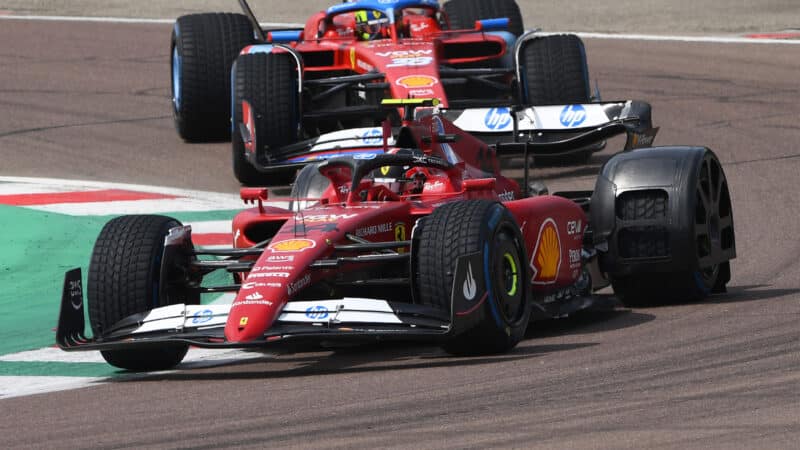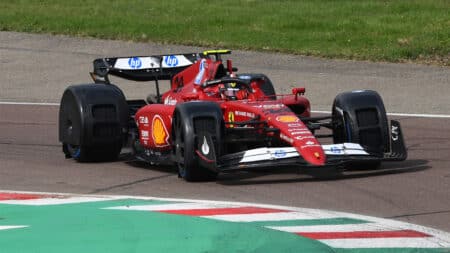The vast volume of displaced water is spun into the the air as spray behind each car. The modern, wider tyres (405mm vs pre-2017 325mm) reduce visibility far more than in previous eras.
Ground-effect aerodynamics, mandated since 2022, worsen the situation by directing even more spray high into the air, forming a curtain that drivers struggle to see through. It’s the main limiting factor for safe wet racing, often leading to long safety car periods or even red flags in order to reduce the amount of water standing on track.
Even if the car in front can drive safely, the one behind might not be able to react to sudden changes, as seen in the 2025 British GP, where Isack Hadjar crashed into the back of Kimi Antonelli when he couldn’t see the Mercedes in front.
In decades past, F1 accepted these risks and continued grands prix when drivers were effectively racing blind, but an increased concern for safety has imposed a more cautious approach.

Intermediate tyres (left) have shallower grooves than the blue-sidewalled full-wets
Red Bull
Aquaplaning risk
While visibility remains the main limiting factor for F1 cars to race under heavy rain, staying in touch with the track is also an issue, especially when water pools on the surface.
Despite the full-wet tyres’ incredible capacity to displace water, they also have their limitations.

Rain all too frequently halts racing in the modern era
Grand Prix Photo
If standing water accumulates faster than the tread can clear it, the car begins to aquaplane — riding on a layer of water rather than the asphalt itself.
The cars’ low ride-height can also create the same effect where the plank underneath the car floats over puddles.
Once that happens, the driver becomes a passenger. A recent example was Charles Leclerc slamming into the wall at relatively low speed as he was on his way to the grid ahead of the season-opening Australian Grand Prix.
Solutions to racing in the rain
Wheel arches
Racing’s governing body, the FIA, has trialled wheel arches, which would be fitted to F1 cars when grands prix are red-flagged due to rain, allowing racing to resume much quicker.
The ungainly solution was meant to contain the spray from tyres and was tested at Silverstone in 2023 with Mercedes and McLaren cars fitted with prototype arches. A more extensive test followed in mid-2024 by Ferrari, with real-time visibility analysis and feedback from drivers.

New wheel arches applied just to the rear of Leclerc’s Ferrari
Getty Images
However, it was ultimately a failure. The arches not only failed to make enough of a difference to visibility — they had no impact on the spray produced by ground effect — but they also introduced aerodynamic complications.
“It was quite similar. So I think back to the drawing board, we need to keep looking at it,” Ollie Bearman said last year after testing at Fiorano.
“The visibility was still pretty tough out there. It was slightly better for sure, the work has gone to something, but not fixed. We did four or five runs just trying different levels of openness, because if it (the cover) is fully closed, it’s also quite tough for the temperature of the tyres.”
New 2026 regulations
Next year’s rule reset will cut downforce, and ground effect will be reduced. Wheels will be narrower too (25mm at the front and 30mm at the rear). Both of these measures should reduce the volume of spray in the air, but visibility is still likely to remain minimal when a grid of 22 cars race at speeds of 200mph or more in heavy rain.



